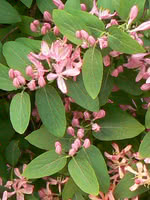Mon-Fri 9am - 5pm Mountain time
Virginia Creeper vs Twining Honeysuckle
Lonicera dioica
Parthenocissus quinquefolia
CUSTOM GROW
Twining Honeysuckle is a vine native to the forests of Canada and the United States.
It can often be found winding up the bark of large trees or spreading out as a ground cover where no supports are present. You will love the attractive, yellow-orange flowers with pink centers which turn into red, inedible berries.
Consider Twining Honeysuckle when trying to achieve a natural, spreading, unkempt look for your garden.
Virginia Creeper is a fast-growing, climbing vine. Its root-like tendrils attach themselves to any non-smooth surface, even brick, but will also grow as a ground cover.
Virginia Creeper makes a beautiful ornamental plant for your garden; its attractive foliage turns from green to deep red in the fall. Birds will love its red berries.
Twining Honeysuckle Quick Facts
Virginia Creeper Quick Facts
Toxicity: berries are toxic

